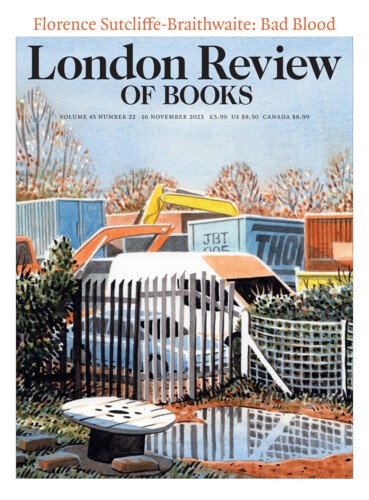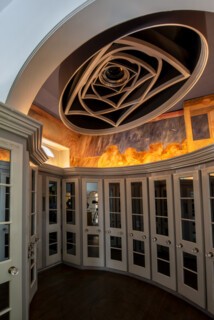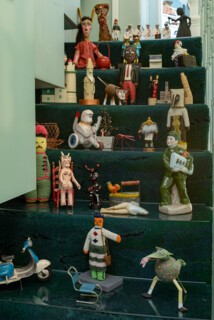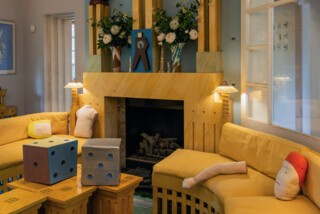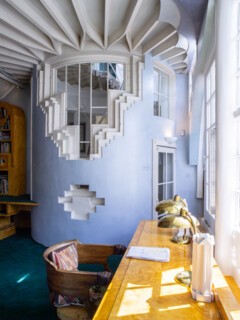Between 1978 and 1983, Charles Jencks worked with the architect Terry Farrell to turn his family’s Victorian end-terrace home in Holland Park into Cosmic House. Jencks died in 2019, two years before the house opened to visitors and nearly fifty years after he defined ‘postmodern’ architecture as an ironic, pluralist style signalling ‘the death of modernist architecture’. Jencks dated the exact moment to 3.32 p.m. on 15 July 1972 (or ‘thereabouts’), when the Pruitt-Igoe public housing development in St Louis was demolished. Jencks said its ruins should be ‘preserved as a warning’.
Cosmic House has been described as Jencks’s manifesto. There are, however, few ruins here. Little remains of the original interior, aside from a sealed-off dog-leg staircase known as Jacob’s Ladder. Instead, the space opens into a series of interconnecting rooms filled with architectural in-jokes. The décor, which combines Jencks’s twin passions for cosmology and architectural history, is an overwhelming display of colour and whimsy. There are mirrors everywhere, so you are forever bumping into yourself. Jencks understood the value of caricature and exaggeration. He described his first book, The Language of Post-Modern Architecture (1977), as a ‘romp through the desolation of modern architecture and our cities, like some Martian tourist out on an earthbound excursion’. Cosmic House, it’s safe to say, attempts to make Martians of us all.
The entrance was originally via the Cosmic Oval, a circular hallway synthesising the key themes of the house. Visitors now enter through the temporary exhibition space in the basement. The ground floor includes rooms named for each of the seasons as well as an Egyptian Room and an Indian Summer Kitchen. There is a Cosmic Loo. The house is part amusement park, part health-and-safety hazard. Steps lead up and down into sunken rooms and annexed spaces. Doubles abound: two doorknobs, two sinks, two toilet flushes (a postcard of a pointing finger alerts you to the right one). Helpful staff redirected me this way and that, across the green-carpeted spaces, and reminded me to watch my step on the cantilevered stone Solar Stair that rises through the centre of the house in a light-filled spiral.
Despite its maximalist appearance, Cosmic House is full of cheap MDF furniture and fittings. Cupboards, doors, mantles, worktops and floors are painted to resemble marble. Jencks admitted that he might have gone over the top. Perhaps he was thinking of the kitchen. Its yellow interior nods to Hindu temples, while a series of fake marble spoons runs around the cornice. ‘If you can’t stand the kitsch get out of the kitchen,’ Jencks liked to say. The Architectural Library is similarly ‘playful’, a favourite term in the postmodern lexicon. Shaped into a cityscape of pitched rooftops and labelled by category, the shelves are accompanied by matching painted units containing Jencks’s slide collection stacked in Kodak and Bendicks Bittermints boxes.
In the 1980s, Cosmic House was a social hub for London’s pomo crowd. This included the Dutch artist Madelon Vriesendorp, whose work – mostly new pieces made especially for the space – is currently on view (until 31 May). Vriesendorp became friends with Jencks in the late 1960s: her then husband, Rem Koolhaas, was one of his students at the Architectural Association and in 1975 Koolhaas and Vriesendorp co-founded the architectural firm OMA. Vriesendorp’s watercolour Flagrant Délit was reproduced on the cover of Koolhaas’s Delirious New York – his ‘retroactive manifesto for Manhattan’ – and forms part of a series of anthropomorphic architectural illustrations and paintings. It depicts the Chrysler and Empire State Buildings in a postcoital coupling, caught in bed by 30 Rockefeller Plaza and lit by the Statue of Liberty’s lamp.
In 2011 Jencks used one of Vriesendorp’s illustrations, in which Frank Gehry’s Guggenheim and Norman Foster’s Gherkin float on a grid of small islands, as the cover for The Story of Post Modernism. Vriesendorp’s Enigmatic Signifier sketches for Jencks’s book combine aspects of the surreal and sexy in their reimagining of key postmodern buildings. Gehry’s stainless steel LA Disney Concert Hall transforms into Marilyn Monroe’s billowing, chiffon skirts, a crumpled handkerchief and two humping dinosaurs. ‘I’m very serious about jokes,’ Vriesendorp says in a short film showing at Cosmic House.
From the mid-1990s, Vriesendorp worked closely with Jencks on his landscape designs as both illustrator and model maker. Some of them are exhibited at Cosmic House, alongside a few of her sketches, although the most impressive pieces are the sculptural works dotted about the house, which are entirely Vriesendorp’s. The blink-and-you’ll-miss-it quality of these couldn’t be further from the scale and ambition of her ‘starchitect’ peers, whose reputations have often overshadowed hers. They fit snugly in Cosmic House’s eccentric spaces – tucked into nooks, plonked on chairs and squirrelled away. At the bottom of the Solar Stair, a cardboard goose watches over a floor mosaic by Eduardo Paolozzi, while a gurning devil’s head made from corrugated board looks down on the Summer Room from a lightwell in the library. A giant blue-grey foot props open a door. ‘She got a foot in the door,’ Vriesendorp quips, a creaky pun she says Jencks would have enjoyed.
This is sculpture both deft and daft. Two squat frogs made from avocado peel sit sentinel next to the taps in the Cosmic Loo. Games without rules and cardboard limbs in plastic tubes teeter between parody and pathos. In the Spring Room, a stuffed and stitched fabric arm, head and torso are propped up on the buttercup-yellow sofa. It’s a bloodless dismemberment, the familial psychodrama as social comedy. Nearby, a stuffed leg overlooks the garden, next to a spotty, bean-shaped cushion. Two oversized cardboard dice, perched on the coffee table, remind us that a bigger game is underway. These and other objects at Cosmic House refer to Vriesendorp’s ongoing Mind Games, which began in the early 2000s as a tabletop exercise carried out with visitors to her studio, who were invited to pick up her artworks and move them around. Jencks described these moveable pieces as Vriesendorp’s ‘mental prosthetics’. She herself calls this ‘playground surrealism’; it’s a form of psychoanalytic play, too. A key describes the symbolic significance of each piece; the dog symbolises ‘Guide & Guard’, the dice ‘Passion & Fate’ and the foot ‘Progress & Permanence’.
Since the exhibition opened, Vriesendorp has taken to dropping by the house to add new pieces. The day before I visited, a plastic fox and a new game arrived: a cardboard box painted bright yellow and punctured by a grid of twelve holes containing witchy fingers. Pig-N-Croc Game, another handmade game in a box, comes with instructions. You have to lift the plastic ice-cream cones until you find the pig, while avoiding the crocodile. Jencks’s ‘Cosmic Suit’ and matching hat is displayed in a mirrored alcove. Made by Vriesendorp in the 1990s, the black and white affair, like a naff magician’s outfit, seems at odds with her use of everyday materials and objects elsewhere.
During lockdown, Vriesendorp saved the empty plastic milk bottles from countless cups of tea, turning them into a series of intricately trimmed and folded sculptures under the name ‘Plastic Surgery’. The group includes a plump, pint-sized fairy and a trio of four-pint elephants circling a table lamp. A bookcase in the Spring Room houses a number of oddball characters, from a spiky-haired Dennis the Menace to an old-fashioned milkmaid. A Chinese Dragon, formed from 25 milk bottles concertinaed one inside another, is suspended from wires. Vriesendorp makes no environmental point with these works. She simply enjoys what Roland Barthes described as plastic’s ‘opaque, creamy and curdled’ quality. Barthes didn’t know what we now do about plastic’s afterlife, but he recognised, like Vriesendorp, its strangely fugitive nature: so ubiquitous as to be near invisible and endlessly adaptive, with the potential to become ‘buckets as well as jewels’.
A bevy of plastic swans occupies the Garden Jacuzzi, modelled on a Borrominian dome, though there isn’t any water (the jacuzzi itself was hardly ever used as it didn’t get hot enough). The necks of the swans, like the trunks of the elephants, are formed from the curved handles of milk bottles, snipped off and fashioned into red-tipped beaks. The wings fan out from each side of the bottle in delicate fronds. There are a few buckets among the jewels, although as with all things postmodern, bad taste is embraced along with the good. The cardboard animals in honey bottles were a bit too sweet for me. I felt the same way about ‘Mr Mysterioso’, a cardboard figure who oversees the Mind Games, and his counterparts reading books in the library (are they supposed to be Vriesendorp and Jencks?). I like a good pun, but the arm-shaped ‘Handelier’ dangling over the stairwell wasn’t as successful as the cardboard dog propped against the window to welcome visitors and confuse local cats.
Writing about Vriesendorp has tended to focus on her role as a collector of postcards, souvenirs and various other forms of tourist tat, from metal toys and plastic models to knitted dolls and trinkets. A group of such doodads fills the blocked-off staircase, an ersatz response to Jencks’s collection of Chinese scholar’s rocks, which are placed out of view on the inaccessible top flight of stairs and only visible in a mirror.
The figure of the artist as archivist or ‘collector’ has an avant-garde lineage. Idiosyncratic modes of inventorying, listing and reordering are a much mined modernist staple. So too is working on a small scale with the discarded remnants of everyday life. When Vriesendorp stands a plastic plug protector on its back and paints small black ‘windows’ on its three upright prongs, she makes a cityscape of a nondescript object, looked at as though through the wrong end of a telescope. A plastic trifle tub placed over these tiny skyscrapers turns the scene into a Buckminster Fuller geodesic dome in miniature. Neither modern nor ‘postmodern’ quite describes her odd, outlier objects. No manifesto here, they quietly do their own thing, and are all the better for that.
Send Letters To:
The Editor
London Review of Books,
28 Little Russell Street
London, WC1A 2HN
letters@lrb.co.uk
Please include name, address, and a telephone number.
